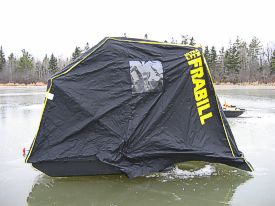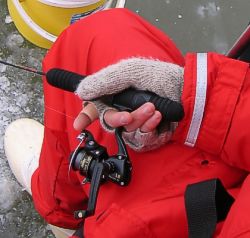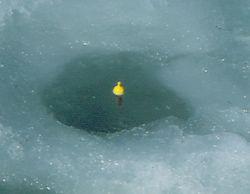Closing the Deal: Hooking Light
Biters
by Tim Allard
At some point in everyone's angling experience we
have been out-fished by someone. The reasons vary but one major
factor for success is how well you can detect subtle strikes. This
skill is particularly important when ice fishing. Perch, walleye,
crappie and trout are all guilty, at times, of being light biters
during the hard-water season. Here are some tips to help you hone
your sensitivity to strikes.
Take Shelter and Remove the Distractions:
 Paying
attention is important to hooking light biting fish. A second can be
all it takes for a crappie to inhale and spit out your bait. If
you're daydreaming you'll miss the strike. Worse yet, if you're not
focused, you won't be able to keep track of what presentation
triggered the bite. Paying
attention is important to hooking light biting fish. A second can be
all it takes for a crappie to inhale and spit out your bait. If
you're daydreaming you'll miss the strike. Worse yet, if you're not
focused, you won't be able to keep track of what presentation
triggered the bite.
When ice fishing a shelter is a great tool to
eliminate distractions and stay comfortable. Being uncomfortable
negatively affects your success. If you're cold, that's distracting
you and limiting your ability to focus on fishing - distraction
equates to missed fish. Shelters also block the wind from blowing
your line, which is critical to successfully working light baits as
well as feeling faint strikes. A slight shift in line may be the
only sign of a hit. To improve your ability to detect bites try
carefully watching your line, placing your finger on the line for
extra sensitivity, and keeping the hole ice-free. Some shelters are
also designed to block out light when fully closed, allowing you to
sight fish in clear water. This can help you determine what
presentation style is effective by watching how fish react to the
bait.
Tone Down Your Presentation:
 Light
biting fish can still be enticed to bite and, in some cases, are
often quite active. Yet, once a few fish get caught and the
adrenaline flows, many anglers speed up their presentation to try
and hook another one. It is important to continue to use the
presentation style that resulted in the first catches. When fish are
aggressively feeding this may not matter, but light biting fish can
be finicky. Light
biting fish can still be enticed to bite and, in some cases, are
often quite active. Yet, once a few fish get caught and the
adrenaline flows, many anglers speed up their presentation to try
and hook another one. It is important to continue to use the
presentation style that resulted in the first catches. When fish are
aggressively feeding this may not matter, but light biting fish can
be finicky.
The following are some presentation methods for
light biters. Swim the bait, moving the rod from one side of the
hole to the next or slowly making a circle. Lightly jiggle the bait,
keeping it in place and making it shake slightly. Lift and lower
your bait with long pauses in between. Dead stick the bait, keeping
it entirely motionless after the initial drop. Lastly, a small
twitch or a jiggle after long pauses can often entice a fish to
bite. Give these subtle presentations a try next time you encounter
light biting fish and you'll likely hook more fish.
Scaling Down Tackle and Hook Positioning:
Reducing your bait size or changing the position of hooks can
increase your success. Switching to smaller sized lures or reducing
bait portions, like jigging a tail instead of a whole minnow can
often produce results. Trying vertical and horizontal hook style
lures or adding a stinger hook are changes you can try to better
your hooking percentage. Also, experiment with how you position the
hooks when using bait. For example, if unsuccessful with hooks sets
when using a single hook through a minnow's nose, try changing to a
small treble behind the dorsal fin or in front of the tail.
Sometimes a small adjustment can make a difference when fish are
lightly taking the bait. Finally, hooks should always be razor
sharp.
 Another
critical tool to detecting light biters is a slip bobber or strike
indicator. I learned the importance of these when out fishing for
trout with small jigs. It wasn't until I started using a slip bobber
that I was able to see the slow, steady take of a trout, but once I
did it was non-stop ice-out action. Use just enough float to allow
you to monitor your lure as too much resistance can cause fish to
drop the bait. Another
critical tool to detecting light biters is a slip bobber or strike
indicator. I learned the importance of these when out fishing for
trout with small jigs. It wasn't until I started using a slip bobber
that I was able to see the slow, steady take of a trout, but once I
did it was non-stop ice-out action. Use just enough float to allow
you to monitor your lure as too much resistance can cause fish to
drop the bait.
Ice fishing for light biters can be a test of one's
attention. To maximize your time on the ice, use a shelter to block
wind so you can properly fish and monitor your lure. Once set up,
experiment with different presentation techniques and bait sizes to
entice light biters. Finally, set the hook at the slightest twitch
in your rod or line with a steady upward pull and reel in line to
drive the hooks home, maintaining pressure throughout the fight. A
light biting fish may only lightly move your rod, but once hooked
they transition to lively fighters leading to pure ice fishing
excitement.
Don't forget to visit
www.ontarioicefishing.net
Dymara also has some DYNAMITE ice fishing jigs!! |